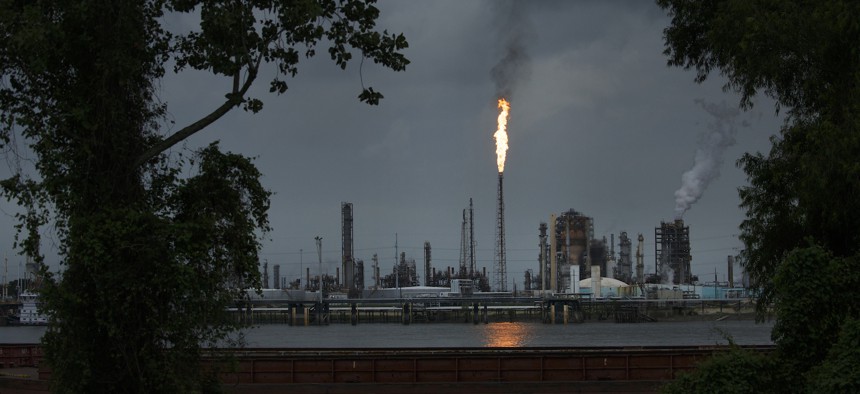
A gas flare from a petroleum refinery in Norco, Louisiana. Drew Angerer/Getty Images
EPA Sued Over Failure To Set, Update Pollution Limits
The lawsuit, filed last week, centers on the Clean Water Act.
More than a dozen environmental groups are suing the federal Environmental Protection Agency over its failure to set water pollution limits for some industrial contaminants as well as its reluctance to update decades-old standards for others, arguing that the agency’s inaction amounts to a “free pass to pollute” for hundreds of chemical and fertilizer plants, oil refineries, plastics manufacturers and other industrial facilities.
“It’s completely unacceptable that EPA has, for decades, ignored the law and failed to require modern wastewater pollution controls for oil refineries and petrochemical and plastics plants,” said Jen Duggan, deputy director of the Environmental Integrity Project, a nonprofit focused on environmental law enforcement that coordinated the lawsuit by 13 environmental groups. “We expect EPA to do its job and protect America’s waterways and public health as required by the Clean Water Act.”
The EPA did not immediately comment on the lawsuit.
The lawsuit, filed Tuesday, centers on the Clean Water Act, the landmark Nixon-era legislation that regulated the discharge of pollutants into waters of the United States. In a letter to the agency advising that the lawsuit was being filed, the Environmental Integrity Project noted that the act requires EPA to establish pollution limits based on the best available treatment methods and then review the limits yearly and every five years “to keep pace with advances in technologies to reduce — and ultimately eliminate — water pollution from industrial sources.”
However, for 40 of the 59 industries subject to the pollution limits, the standards were “last updated 30 or more years ago, and 17 of those date back to the 1970s,” the EIP says.
“These point-source categories are large sources of water pollution, dumping billions of gallons of wastewater into our rivers, streams and lakes each year,” the group said, noting that EPA standards in many cases “do not limit discharges of nutrient pollution or toxics like benzene, mercury, polycyclic aromatic hydrocarbons (PAHs), selenium, per- and polyfluoroalkyl substances (PFAS), and heavy metals.” The suit alleges that the EPA’s decision not to update the regulations is “arbitrary, capricious, an abuse of discretion or otherwise not in accordance with law” under the federal Administrative Procedure Act.
About half of all the river and stream miles and lake acreage in the U.S. fail to meet water quality standards because of pollution, “which means half the country’s assessed waterways do not support intended uses like aquatic life and drinking water, the EIP says.
Duggan said if the EPA required, for example, the modern treatment controls that are standard for municipal sewage plants that discharge into the Chesapeake Bay — like denitrification, which removes nitrates and nitrite compounds that can lead to large algal blooms — water pollution could be cut significantly.
Eighty-one oil refineries across the U.S. discharged nearly 16 million pounds of nitrogen pollution into streams, rivers, lakes and bays in 2021, the group says. Carbon and mechanical filtration technologies could also be used to remove heavy metals like lead, arsenic, selenium and PFAs, the “forever chemicals” that have been linked to potential increased cancer risk and a host of other health problems.
“EPA simply cannot fulfill its mandate of setting increasingly protective, technology-based pollution limits for these and other industrial categories if EPA does not regularly review whether existing limits reflect best available technology and other recent technology,” the EIP wrote in its letter.
Tightening restrictions would affect about 1,185 plants across seven industrial categories, the EIP said. Some of the biggest polluters are oil refineries and ammonia nitrogen fertilizer plants, many of them concentrated along the Gulf Coast.
But during a new conference announcing the lawsuit, representatives from environmental groups said the problem stretches from the slew of chemical and refineries along the banks of the Mississippi River (dubbed “Cancer Alley”) in southern Louisiana to Newark, N.J.’s “chemical corridor,” the shores of Lake Michigan and to the San Francisco Bay, with many others in between. They noted that pollution tends to fall heaviest on poor and minority communities.
“For decades the EPA has let these dirty industries pollute our rivers and bays instead of making them keep pace with advances in technologies that tackle water pollution, as the Clean Water Act demands,” said Hannah Connor, the environmental health deputy director at the Center for Biological Diversity, a nonprofit focused on protecting endangered species. “Forcing people and wildlife like endangered Atlantic sturgeon to bear the weight of toxic water pollution while industries rake in record profits isn’t just morally wrong, it’s also legally indefensible. EPA needs to bring pollution standards into the 21st century.”
Kansas Reflector is part of States Newsroom, a network of news bureaus supported by grants and a coalition of donors as a 501c(3) public charity. Kansas Reflector maintains editorial independence. Contact Editor Sherman Smith for questions: info@kansasreflector.com. Follow Kansas Reflector on Facebook and Twitter.






